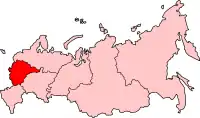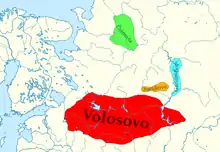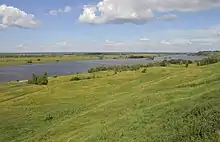Volosovo culture
The Volosovo culture is an archaeological culture that followed the Neolithic Pit-marked pottery culture (Balakhna). The archaeological assemblage identified with this culture is related to the finds from the middle Volga and Kama basin, indicating that they originated from the east.[3]
 | |
| Geographical range | Central Russia |
|---|---|
| Period | Neolithic to early Bronze Age |
| Dates | 4000-2000 BC or 1800-1500 BC |
| Major sites | Volga, Kama, Oka River, Veletma River |
| Preceded by | Balakhna, Lyalovo[1] |
| Followed by | Netted Ware culture[2] |
Volosovo culture emerged sometime between the third and fourth millennium B.C. and lasted until the second millennium BC.[4] A more specific estimate was the period between 1800 and 1500 BC, overlapping with the Early Bronze Age Fatyanovo culture.[5]
The people of the Volosovo culture has been described as forest foragers.[6][7]
Discovery

The Volosovo culture was discovered in the 1900s. Like other groups with forest origin such as the Garin-Bor and other northern cultures, the Volosovo lived in the forest steppes of the Volga-Ural region, particularly the area of the present-day Samara oblast.[8] Specific sites include those in central Russia, the Middle and Lower Oka,[9] Lower Kama, and Middle Volga.[3] The culture also inhabited the Veletma River area adjacent to Murom, a city that is part of Vladimir Oblast.[3] The Veletma River site was excavated from 1877 to 1928.
Since the discovery of the Volosovo culture, it has been investigated extensively but it remains controversial due to some unresolved aspects, particularly the chronology of its history, cultural attributes, origin, and ethnic affiliations.[3] For example, it was believed that Volosovo was a separate cultural entity but other studies show that it is related to cultures associated with the Volga and Kama basin.[5]

Characteristics
The stone and ceramic artifacts that are used to describe the Volosovo culture were from the semisubterranean dwellings, which are often situated in river floors and within the area of lakes.[3] These dwellings have lower and upper cultural layers. The artifacts found in the lower layer indicates a cultural affinity with the Russian Pit-marked Pottery culture called Balakhna.[5] The upper level, which is considered the actual Volosovo phase, included ceramics that were distinct from the pit-marked pottery as well as those attributed to contemporaneous cultures such as the Fatyanovo culture.[3]
Based on excavated artifacts, the Volosovo culture first used stones and bone tools and were particularly adept at bone carving and sculpture.[4] A small art emerged, one that has been considered rich and diverse as demonstrated by the varied flaked flint sculptures that represented the human form.[4] This phenomenon was distinguished from what manifested in the Tokareva culture.[4]
The culture transitioned out of the Neolithic Age and abandoned its stone and bone technologies after learning early metal working.[4] Later in its development, an early form of agriculture emerged with evidence of domestic animals.[4] Discovered cranial and long bones of a primitive turbary dog, for example, showed improved animal breeding.[9] However, the culture still favored foraging, hunting, and fishing.[4] It is suggested that there emerged an animal cult among the Volosovo population after 1500 BCE as evidenced by the use of animal teeth and bones on ornaments such as necklaces.[10] According to this theory, bears were worshiped for their power while dogs and pigs were revered for their economic value.[10]
A late Volosovo culture emerged later on and this phase was associated with the sites located in the upper Volodary and Panfilovo.[5]
Cultural contacts
There is evidence that the Volosovo culture had extensive contacts with other cultures such as the Balanovo culture, a group considered to be the metal-working aspect of the eastern Fatyanovo.[6] This is also demonstrated by the existence of Fatyanovo ceramics in Volosovo sites as well as the discovery of Volosovo ceramics in Fatyanovo graves.[3] Evidence showed that the late Volosovo phase also had extensive contact with the Abashevo population, helping spread cattle-breeding economies as well as metallurgy among the northern forest cultures.[6] There were also Volosovo populations that were absorbed into the Abashevo culture before 2500 BCE while others were moving north.[8]
The Volosovo people also maintained contacts with linguistic relatives who settled in Finland and Russian Karelia as well as Proto-Baltic speakers, who were later absorbed into the culture.[1]
References
- Bryant, Edwin Francis; Patton, Laurie L. (2005). The Indo-Aryan Controversy: Evidence and Inference in Indian History. Oxon: Psychology Press. p. 127. ISBN 0-7007-1462-6.
- Mailhammer, Robert (2015). The Linguistic Roots of Europe. Copenhagen: Museum Tusculanum Press. p. 84. ISBN 9788763542098.
- Dolukhanov, Pavel (2013). The Early Slavs: Eastern Europe from the Initial Settlement to the Kievan Rus. Oxon: Routledge. pp. 88–89. ISBN 9780582236189.
- Kir'iak, M. A. (2007). Early Art of the Northern Far East: The Stone Age. Anchorage: U.S. Department of the Interior, National Park Service, Shared Beringian Heritage Program. p. 96. ISBN 9780160822223.
- Gimbutas, Marija (1965). Bronze Age cultures in Central and Eastern Europe. The Hague: Mouton & Co., Publishers. pp. 627, 630. ISBN 9783111668147.
- Anthony, David W. (2007). The Horse, the Wheel, and Language: How Bronze-Age Riders from the Eurasian Steppes Shaped the Modern World. Princeton, NJ: Princeton University Press. p. 382. ISBN 9780691058870.
- Hanks, Bryan K.; Linduff, Katheryn M. (2009). Social Complexity in Prehistoric Eurasia: Monuments, Metals and Mobility. New York: Cambridge University Press. pp. 308. ISBN 9780521517126.
- Anthony, David W.; Brown, Dorcas R.; Khokhlov, Aleksandr A.; Kuznetsov, Pavel F.; Mochalov, Oleg D. (2016). A Bronze Age Landscape in the Russian Steppes: The Samara Valley Project. Los Angeles: Cotsen Institute of Archaeology Press. p. 114. ISBN 9781938770050.
- Harding, Anthony; Fokkens, Harry (2013). The Oxford Handbook of the European Bronze Age. Oxford, UK: Oxford University Press. p. 338. ISBN 9780199572861.
- Pungetti, Gloria; Oviedo, Gonzalo; Hooke, Della (2012). Sacred Species and Sites: Advances in Biocultural Conservation. Cambridge: Cambridge University Press. p. 278. ISBN 9780521110853.